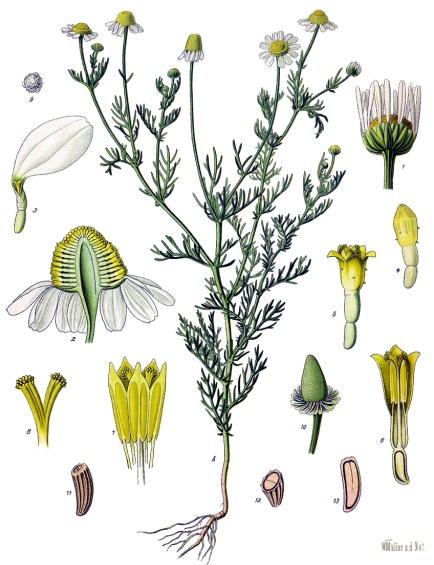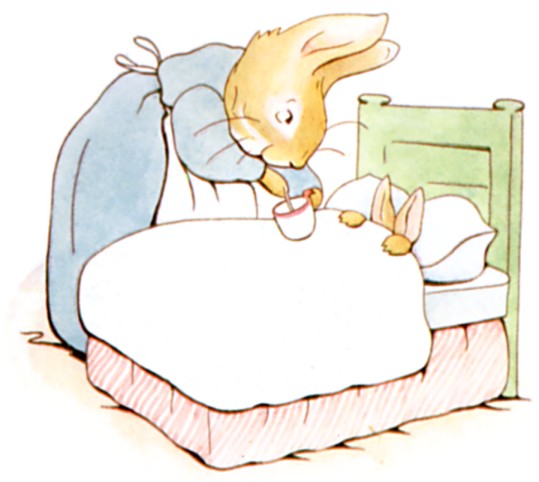
Chamomilla recutita (L)
 Synonyms and Common names: Matricariae flos, Matricaria
chamomilla (L.), Matricaria recutita (L.), Single chamomile,
Hungarian chamomile, pinheads, scented mayweed, sweet false chamomile
Synonyms and Common names: Matricariae flos, Matricaria
chamomilla (L.), Matricaria recutita (L.), Single chamomile,
Hungarian chamomile, pinheads, scented mayweed, sweet false chamomile
German = Hundskamille, French = Camomille, Italian = Camomilla, Spanish = Camomile
Order: Compositae
Description: Chamomilla is an erect annual, up to 60cm in height, with wispy 2-3 pinnate leaves and terminal peduncles supporting single flowerheads. Yellow tubular florets without membranous bracts are implanted on a raised and hollow receptacle. This is surrounded by a single row of white ligulate florets which are often bent backwards. Chamomilla grows in fields and many other places throughout England, Europe, Russia and Asia, and is naturalised in Australia and the US.
Parts used: flowers head, essential oil
Collection: the flower heads are collected when they are mature and
expanded, from June to August. They should be
dried carefully in the shade and stored in a cool dark place.
Constituents: 0.3-2% volatile oil (including bisabolol); bitter glycosides (anthemic acid); flavone glycosides (anthemidin), coumarins (including umbelliferon and herniarin), phenolic carboxylic acids, polysaccharides, mucilage, choline, amino acids, tannins, malic acid. Blue chamazulene is formed from the sesquiterpene lactone matricin during steam distillation.
Actions: anti-inflammatory, spasmolytic, vulnerary, antimicrobial, mild sedative, carminative, antiseptic, anticatarrhal.
Indications: Internally for spasm or inflammatory conditions of the gastrointestinal tract, peptic ulcer, flatulent or nervous dyspepsia, travel sickness, nasal catarrh, restlessness, mild sleep disorders. Specifically indicated in gastrointestinal disturbance with associated nervous irritability in children. Topically for haemorrhoids, mastitis, leg ulcers, eczema and irritations of the skin and mucosa anywhere in the body.
Therapeutics and Pharmacology: Chamomilla has a wide range of actions. It is used in the treatment of insomnia, anxiety and nervous tension, for the relief of spasmodic pain such as dysmenorrhoea or migraine, and is a safe remedy for children�s problems with a nervous component. This spasmolytic action is due to the presence of flavones, bisabolol and other constituents of the volatile oil. This herb is particularly suited to digestive problems such as nervous dyspepsia and colic. The dicyclic ether in the volatile oil relaxes the smooth muscle, regulating peristalsis, while the carminative volatile oil reduces flatulence and irritation of the gut wall. The bitter glycosides stimulate the appetite and digestive activity, and the herb also helps relieve inflammatory conditions of the upper digestive tract.
Chamazulene and bisabolol directly reduce inflammation in tissues with which they come into contact, stimulate the formation of granulation tissue, and have an antibacterial action. Bisabalol is also protective against ulcers. The polysaccharides are have an immunostimulant action, activating macrophages and B-lymphocytes, thus demonstrating a scientific basis for the use of the herb in the topical treatment of wounds and ulcers. Chamomilla also makes an effective lotion for eczema, a mouthwash or eyewash, or as a steam inhalation for catarrh and inflamed mucous membranes.
Chamomilla has a reputation as a �female� herb and has been used to relieve morning sickness, menopausal symptoms, dysmenorrhoea, mastitis, amenorrhoea with a psychological component (e.g. anorexia nervosa), and hysteria.
Chamomilla has a traditional use on the Continent in the treatment of asthma and hayfever, probably due to the herb�s action on the mucous membranes of the upper respiratory tract. It is thought to reduce the reaction to allergens such as pollen or dust in sensitive individuals.
Combinations: Chamomilla combines well with Althaea, Filipendula, Ballota and Humulus in nervous dyspepsia, and with Valeriana, Passiflora and Humulus in restlessness.
Caution: Contact allergy is rare.

Preparation and Dosage: (thrice daily)
GSL Schedule 1
Dried flower heads: 2-4g or by infusion
Liquid Extract: 1:1 in 45% alcohol, 1-4ml
Tincture: 1:5 in 45% alcohol, 3-10ml
Externally: infusions or semi-solid preparations containing 3-10% of the drug
Additional Comments: Chamomile is known as the plants' physician because it is said that ailing garden plants will recover when it is planted next to them. Called maythen by the Anglo-Saxons, it was one of the nine sacred herbs given to the world by the god Woden. The root was traditionally chewed to relieve toothache. Chamomile is used in homoeopathic medicine for inner turmoil, anxiety, anger, convulsions, throbbing headache, earache, teething, hacking coughs, dysmenorrhoea and diarrhoea.
I am sorry to say that Peter was not very well during the evening.
His mother put him to bed, and made some camomile tea; and she
gave a dose of it to Peter! 'One teaspoonful to be taken at bed-time.'
Beatrix Potter, 'The Tale of Peter Rabbit'
Bibliography
Bartram, T. 1995 Encyclopedia of Herbal Medicine, 1st edn.,Grace Publishers, Bournemouth.
Bradley, P.R. (ed.) 1992 British Herbal Compendium, Volume 1, BHMA, Bournemouth.
Bremness, L. 1994 Herbs, Dorling Kindersley Eyewitness Handbook, London.
BHMA 1983 British Herbal Pharmacopoeia, BHMA, Bournemouth.
Chevallier, A. 1996 The Encyclopedia of Medicinal Plants, Dorling Kindersley, London.
Grieve, M. 1931 A Modern Herbal, (ed. C.F. Leyel 1985), London.
Hoffmann, D. 1990 The New Holistic Herbal, Second Edition, Element, Shaftesbury.
Hyperhealth 1996 Natural Health and Nutrition Databank, v.96.1 CD-ROM, �In-Tele-Health, available from Healthworks, Leeds. ISBN 0-646-30942-0
Lust, J. 1990 The Herb Book, Bantam, London.
Mills, S.Y. 1993 The Essential Book of Herbal Medicine, Penguin, London (First published in 1991 as Out of the Earth, Arkana)
Newall, C.A., Anderson, L.A., & Phillipson, J.D. 1996 Herbal Medicines: A Guide for Health-care Professionals, The Pharmaceutical Press, London.
Ody, P. 1993 The Herb Society's Complete Medicinal Herbal, Dorling Kindersley, London.
Polunin, M. and Robbins, C. 1992 The Natural Pharmacy, Dorling Kindersley, London.
Prihoda, A. 1989 The Healing Powers of Nature, Octopus, London.
Vickery, R. 1995 A Dictionary of Plant Lore, Oxford University Press.
Weiss, R.F. 1991 Herbal Medicine, Beaconsfield Arcanum, Beaconsfield.
Wren, R.C. 1988 Potter's New Cyclopaedia of Botanical Drugs and Preparations, C.W.Daniel, Saffron Walden










